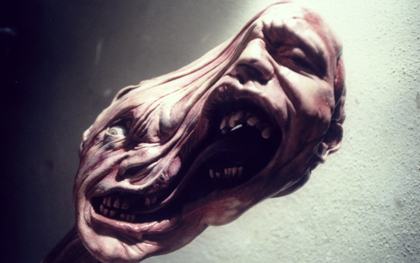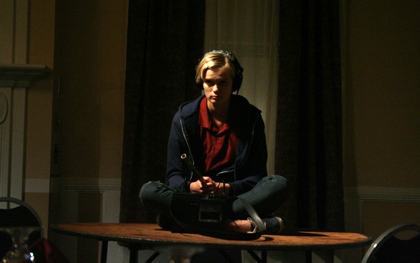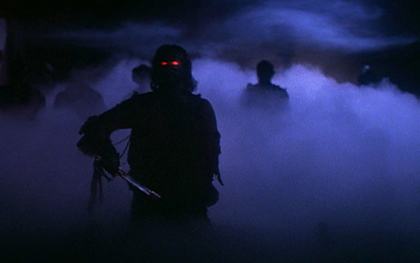Festival and symposium review
Horror film sound:
Songs in the key of fear

John Carpenter’s The Thing, scored by Ennio Morricone
Mark Pilkington tunes into terror at London FrightFest and at Sound and Music’s ‘Sound of Fear’ showcase
Since Bela Lugosi first grooved to the children of the night in Tod Browning’s Dracula (1931), the genre has relied, perhaps more than any other, on music and sound effects for its power. It’s no surprise then that the two best-known film music cues are both associated with horror – Bernard Herrman’s string stabs for Psycho (1970) and John Williams’ prowling bass line from Jaws (1975).
At FrightFest this year, Larry Fessenden (Wendigo (2001), The Last Winter (2006)), one of the genre’s most thoughtful filmmakers, described how he would often just listen to the audio tracks of his favourite films to understand the role that sound played. Listening to this year’s crop of films, two stood out for using sound and music to thrilling effect.
Ben Wheatley’s festival hit Kill List features an adventurous soundtrack by composer Jim Williams (who also worked on Wheatley’s 2010 Down Terrace). As the tension is ratcheted up so the soundtrack becomes increasingly unsettling, sparse martial rhythms interrupted by stabs of percussion and human and animal howls, accentuating and underscoring the onscreen dissonance without ever overwhelming it. Wheatley told the audience that they used the music of Morton Feldman as inspiration during the edit.

The Innkeepers
Ti West’s enjoyable, old-fashioned shaggy ghost story The Innkeepers (produced by Fessenden) makes good use of sound to enhance the eerie ambiguity of its slacker ghost-hunters’ experiences. As they roam their haunted hotel with an audio recorder, we enter its sonic environment, where every fluctuation in static or exhalation by the air conditioning unit takes on new meaning and… wait… was that a woman crying?
These sequences play on amateur Most Haunted-style ghost-hunters’ enthusiasm for gathering ‘EVP’ (Electronic Voice Phenomena), alleged anomalous recordings of sounds and voices from ‘the other side’. Whether the sounds on the recordings are genuine spirit manifestations or meaningless audio artefacts depends on which side of the paranormal divide you stand, and The Innkeepers neatly reflects these ambiguities without, as so many horror films do, breaking its sonic fourth wall and blurring the lines between what its protagonists and its audience can hear (have a listen to Oren Peli’s 2007 Paranormal Activity, for example).
Sound of Fear
Complementing FrightFest, Sound and Music’s ‘Sound of Fear: The Musical Universe of Horror’ event at the South Bank Centre on 3 September explored the relationship of music, sound and horror film through performances and discussion.
First up was sound artist People Like Us, aka Vicki Bennett, whose Horror Collage juxtaposed clips from classic and not-so-classic films with wryly-selected pop tunes, drawing out those eternal horror conflicts of domesticity and fantasy, mundanity and magic, good and evil.
South Korean artists Lee Hangjun, Hong Chulki and Choi Joonyong presented After Psycho Shower, a work for three projectors and two turntables that distilled Janet Leigh’s iconic death scene into its constituent audio and visual elements. The triple-screen red, green and blue projections and increasingly degraded soundtrack took us beyond her death into an abstract, chaotic afterlife of glitchy sprocket rhythms, abrasive noise and unstable imagery. Leigh’s death, however, was not the end, and as the performance took on a durational aspect, one wondered whether the audience wasn’t being subjected to a vein of the sadistic black humour present in many South Korean horror films.
International ensemble zeitkratzer’s A Musical Compendium of Horror explored horror soundtrack tropes as eerie voices, detuned strings, brass squawks and squeals, music box piano and foley sounds built up to a crescendo of screams, crashing glass, snapping wood, hammered piano and thunderous timpani.
For most in attendance however, the evening’s main musical draw was a considerably more low-key performance featuring a monk-haired man playing simple, repetitive tunes on a MIDI keyboard and a misbehaving laptop. This was Alan Howarth, regular musical collaborator with director John Carpenter and provider of sound effects to countless horror films. Try as it might to break the spell, Howarth’s possessed computer couldn’t dampen the audience’s enthusiasm for renditions of themes from Halloween (1978), The Thing (1982) – for whose score Ennio Morricone aped Carpenter’s own style – Escape From New York (1981) and more.
Live, lo-fi video-mixing of Carpenter films by Jade Boyd added another performative element to Howarth’s music but, enjoyable as the session was, the addition of a live band would have made it truly thrilling. Still, there’s no faulting the music itself. As Howarth himself said, people criticised Carpenter as a ‘one note Johnny’ – but what a note!

The Fog
The centrepiece of the evening was a discussion between Howarth, Friday the 13th composer Harry Manfredini and horror critics Kim Newman and Stephen Thrower (also a musician who contributed an electronic score to Ben Wheatley’s Down Terrace). In a lively hour the panel scrambled through the history of horror soundtracks, from the use of Swan Lake in early Universal films to Bernard Herrmann’s genre-defining deployment of violins as weapons for Psycho (1960), Krzysztof Penderecki’s avant-garde nightmares used in The Shining (1980), Goblin’s maximalist prog-rock scores for Dario Argento and, at the other end of the spectrum, Howarth and John Carpenter’s sleek electro-minimalism.
Film clips chosen by the panel illustrated how music can breathe life into abstract forces (Carpenter’s The Fog, 1980), provide audiovisual dissonance (c.f. the potentially absurd zombie vs shark wrestling match in Lucio Fulci’s Zombie Flesh Eaters (1979), given dreamlike power by Fabio Frizzi’s lush electronic score) or simply introduce tension into otherwise dull scenes (cue endless shots of people walking through underlit rooms, woods, basements etc asking “Hello, is anyone there?”).
While spooky sounds are often used to denote an unseen presence, sometimes music itself can be that presence – a wonderful example being the opening of Dario Argento’s Suspiria (1977), as Goblin’s delirious horror-prog bleeds through from the outside world each time a set of airport sliding doors opens. As Kim Newman pointed out, with examples such as these, horror films present audiences with experimental ideas and techniques that they might not encounter elsewhere – as good an argument as for the genre’s importance as any.
Is there a secret to successful horror scoring? Alan Howarth thinks so, and let us in on it during a technical hitch in his performance: “One word – dynamics. People are making much too much noise these days.” Sometimes, silence can be the scariest sound of all.
See also
Trashy magic: Frances Morgan on Alan Moore and Edwin Pouncey’s live tribute to Harry Smith, ‘Fourth Dimensional Mind’s Eye Summoning’ (August 2011)
Haunting houses: Jonathan Romney on the Brothers Quay and Alina Ibragimova’s live performance ‘I looked back when I reached halfway’ (August 2011)
The horrordelica… the horrordelica…: Sam Davies on Animal Collective and Danny Perez’s visual album ODDSAC (May 2010)
The best music in film: a special edition (September 2004)
Six degrees of Nosferatu: Thomas Elsaesser on Shadow of the Vampire (February 2001)
Vampires reviewed by Kim Newman (December 1999)
